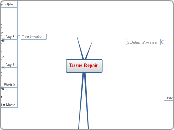Tissue Repair
2 Distinct Processes
Regeneration
Replacement of injured cells by cells of same type
Labile Cells
Continuously dividing cells
Follow cell cycle from one mitosis to the next
Proliferate to replace cells
Regen. derived mostly from stem cells with unlimited regen capacity
Stratified sq. cells of skin, columnar epithelium of GI tract
Stable Cells
Quiescent cells
Normally low level or replication
Rapid division in response to stimuli
Capable of rebuilding tissue of origin
Considered to be G0 but can be stimulated into G1
E.g.
Mesenchymal cells
Vascular endothelial cells
Parenchymal cells of glandular organs
Restitution of normal structure
Needs intact basement Membrane
Underlying supporting stroma of parenchymal cells
Needed for organized regeneration
Cells proliferate haphazrdly if BM disrupted
Fibrosis
Replacement of injured cells by connective tissue
1) Angiogenesis
a) Proteolytic Degradation
BM of parent vessel
b) Migration and proliferation of Endothelial Cells
To angiogenic stimulus
c) Maturation of Cells
Inhibition and remodeling into capillary tubes
d) Recruitment of periendothelial cells
Pericytes
Smooth muscle cells
2) Migration + Proliferation of Fibroblasts
Proliferation triggered by GFs and Cytokines
Formation of granulation tissue framework
3) Deposition of ECM
major portion of connective tissue formed by fibrillar collagens
Fibroblast proliferation decreases over time while ECM deposition increases
4) Remodelling of Fibrous Tissue
Conversion of granulation tissue into scar
Spindle shaped fibroblasrt
Dense collagen
Vascular regression continues as scar matures
Scar formation
Non-dividing cells hence must heal by fibrosis instead
Neurons
Cardiac muscle
Skeletal muscle
First intention
Healing of clean wounds with opposed edges
Immediate response to injury
Wound fills with clotted blood
Dehydration of clot form scab
Acute inflamation occurs with appearance of neutrophils at edge of wound
24-48Hrs
Epidermis at cut edge thickens due to mitotic activity of basal cells
Spurs of epithelial cells migrate and grow along margins
Fusing in midline beneath surface scab
Continuous thin epithelial layer formed
Day 3
Replacement of neutrophils by macrophages
Granulation tissue invades incisional space
Collagen fibers present at margin but do not bridge incision
Epithelial proliferation continues
Day 5
Incisional space filled with granulation tissue
Collagen bridges incision
Epidermis recovers normal thickeness
Week 2
Continued proliferation of fibroblast and accumulation of fibrogen
Leukocyte infiltration, Edema and increased vascularity disappeared
1st Month
Scar comprises of connective tissue covered by intact epidermis
Dermal appendages destroyed by injury are permanently lost
Tensile strength increases gradually thereafter
2nd intention
Occurs in wounds with separated edges
Differences compared to 1st Intention healing
More intense inflammatory rxn
Much larger amounts of grnulation tissue formed
wound contraction present
mediated by myofibroblast
Fibroblast with smooth muscle characteristics
Parenchymal regen cannot fully reconstitute original architecture
Morphology of Granulation tissue
Former site of tissue damage and active inflammation
Occupied by
Proliferating capillaries and fibroblast
Wound Healing
Macrophages and lymphocytes
Resolving inflammation
2 patterns
Early form
Vascular granulation tissue
Leukocytes
Proliferating fibroblasts
Loose connective tissue matrix
Late form
Fibrous granulation tissue
Inconspicuous capillaries and numerous plump activated fibroblasts
